Mix up a batch of this homemade laundry detergent with just a few simple, frugal ingredients to keep your clothes clean and bright. Using goat milk soap makes this the perfect homemade laundry detergent for sensitive skin, and you get to choose the scent by mixing in your favorite essential oils.

Think for a moment about ALL the soaps that touch your skin on a daily basis:
- face wash
- body wash
- shampoo
- hand soap
- dish soap
- laundry soap
If you have dry, itchy skin, your first instinct might be to blame it on your hand soap or body wash. But when you’ve switched to something healthier, whether it’s goat milk soap or something else, and you’re still itchy, you’ve got to go back to the drawing board.
What could be causing itchy legs, itchy arms, AND an itchy belly?
Your laundry soap.
HOMEMADE LAUNDRY DETERGENT FOR SENSITIVE SKIN
Yes, the one thing you thought wouldn’t really affect your skin – because it doesn’t actually touch your skin – could be the cause of your skin irritations.
You don’t have to physically touch laundry detergent to react to the ingredients inside. You can wash, rinse, rinse again, and dry and STILL have skin irritations thanks to the tiny remnants left behind.
The only way to know for sure if you’re sensitive to commercial laundry detergent is to switch to a different kind for a short period and see if you notice a difference.
Here’s the catch though: sometimes it’s not the dyes that cause irritation. It might not even be the fragrances.
Often the real cause of irritation from laundry soap is the SOAP, which means using typical “free and clear” store-bought detergent from your local grocery store won’t solve the problem.
Fortunately, making your own laundry detergent for sensitive skin is very easy, and very affordable. With a few basic supplies and a bar of incredibly gentle goat milk soap (I recommend Bend Soap Company), you can make a batch in less than 15 minutes.
GOAT MILK SOAP FOR HOMEMADE LAUNDRY DETERGENT
I’ve been using goat milk soap for several years now in several of my home and skincare DIY products and let me tell you – my experience with goat milk soap has been life-changing.
- It’s cleared up my acne-prone skin, both on my face and on the rest of my body. (Read more about that here.)
- It’s improved the texture of my skin, making it softer and smoother.
- It moisturized my skin all over, removing the need to use additional lotion every day (which means fewer chemicals!).
And since your skin is the biggest organ you have, using less chemicals on it is a good thing!
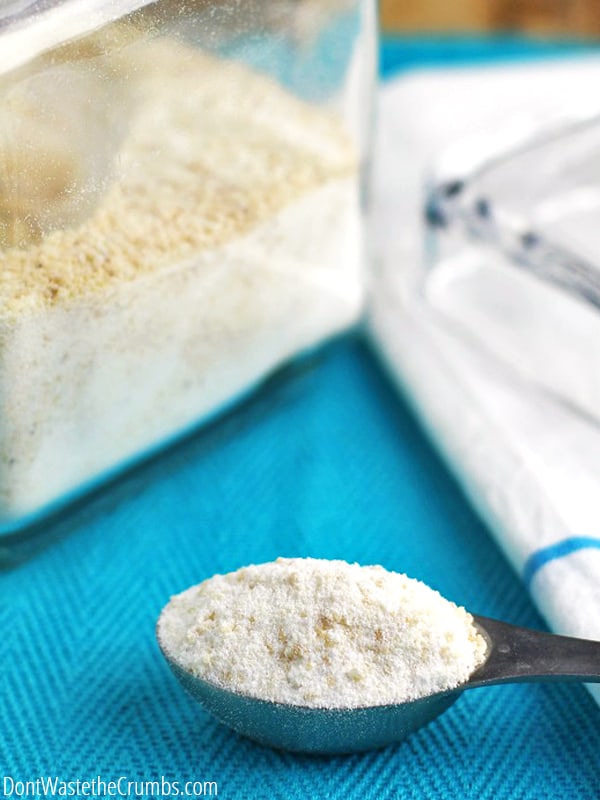
DIY LAUNDRY DETERGENT RECIPE INGREDIENTS
You only need a few ingredients for this DIY laundry detergent recipe:
- 1 bar goat milk soap (I recommend Bend Soap Company)
- baking soda
- borax
- super washing soda (I like Arm & Hammer super washing soda)
- essential oils (optional, but recommended if you like your clothes to have a certain scent other than clean)
ESSENTIAL OILS IN HOMEMADE LAUNDRY DETERGENT
I prefer to add essential oils to my homemade laundry detergent recipe because I like my clothes to have an actual scent after washing. The 20 drops called for in the recipe will leave a very, very light scent – so light, that you might not notice it unless you knew it was there. Feel free to add up to 40 drops of essential oil for a stronger scent.
One fun part of making homemade laundry detergent recipes is that you can create any scent you want. I’ve been using lavender soap shreds with lavender essential oil, but any of these scent combinations would be lovely as well:
- tea tree + lemon
- lemon/orange/grapefruit + peppermint/wintergreen/spearmint/eucalyptus
- tea tree + peppermint
- orange + thieves/cloves/cinnamon bard
- tea tree + rosemary
Note: Plant Therapy is my favorite company for essential oils. You can find their shop here.

HOW TO MAKE LAUNDRY DETERGENT
Step 1. Using a cheese grater, grate your goat milk soap until you have 1 cup of soap shreds. To save time, grate the entire bar and store excess shreds in a container with a lid.
Note: For those who are REALLY short on time or don’t want to mess with shredding soap bars but still want to make laundry detergent, Bend Soap Company now offers pre-shredded goat milk soap HERE. This also comes in handy if you’re making homemade facial cleansers.

Optional: In a food processor or blender, combine grated goat milk soap and baking soda. Pulse until the bar soap is in very small pieces, only slightly bigger than the baking soda granules. Add essential oils (if using) and pulse a few more times.
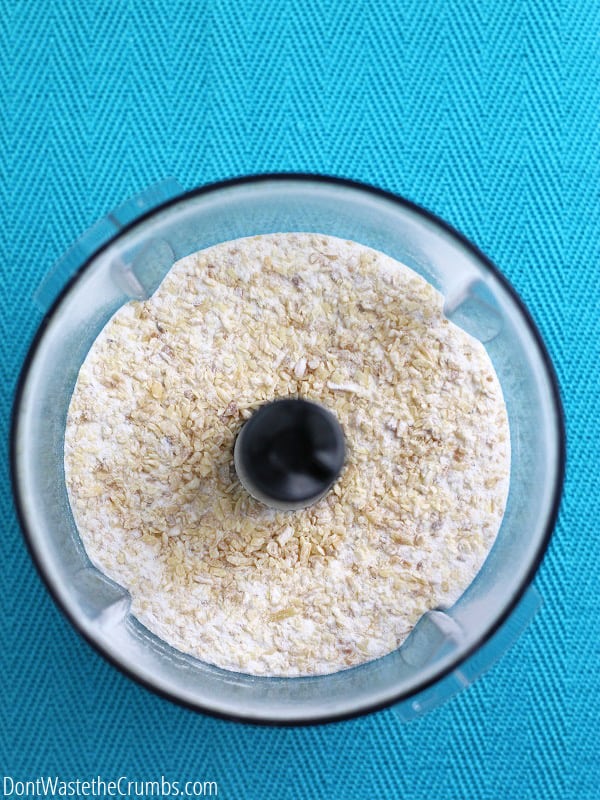
Step 2. In an airtight container, combine all ingredients. Seal well and shake vigorously until all the ingredients are well combined. Be careful when opening the container as small dust-like particles of the ingredients will become airborne. You could also stir the ingredients together if you don’t have a tight sealing lid.
For this homemade detergent, use one tablespoon for a small load, and two tablespoons for a large load. This recipe makes enough for 40 tablespoons, which lasts my family of four approximately one month.
SAFETY PRECAUTIONS WHEN MAKING HOMEMADE LAUNDRY DETERGENT
Although safe for external use, Borax should not be inhaled. Therefore, it is best to use either a mask or some sort of protective barrier over your mouth and nose when handling it and opening the container for the first time.
I pull my shirt up and over my mouth and nose when measuring. Parents, if your children are helping you make laundry detergent, it’s best to handle the box of borax yourself. Also, as a precaution, use protective gloves if you have cuts or open wounds on your hands.
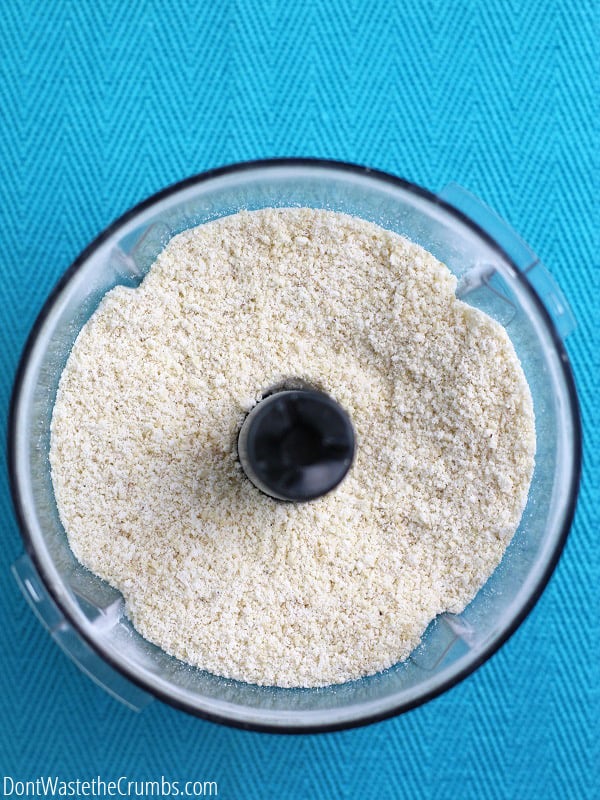
HOW TO STORE HOMEMADE LAUNDRY DETERGENT
I’m using a lovely glass jar that I received as a Christmas gift for my homemade powdered laundry detergent mixture right now, but you can use any storage container that has a lid like this gallon jar. The lid helps to keep out excess moisture, which can ruin your DIY laundry detergent.
A 5-gallon bucket might be a little bit overkill for this particular laundry soap recipe, but if that’s what you have on hand, use it!
I’m also repurposing an old coffee scoop for measuring. In case you didn’t know, coffee scoops are equivalent to 1 tablespoon, and they tend to be made a bit stronger than most measuring spoons.
Bonus: Skip the fabric softener and dryer sheets by using wool dryer balls! Or you can save even more money by skipping the dryer and hang-drying your clothes, even indoors!
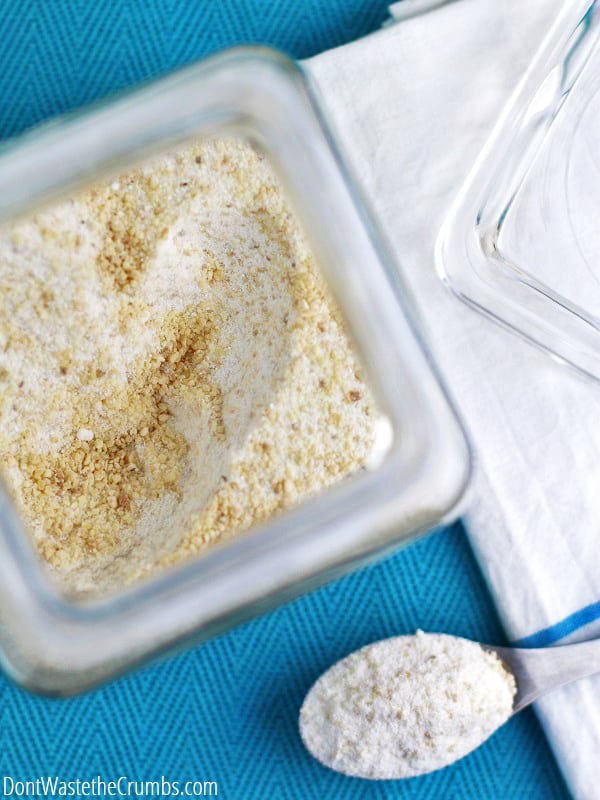
WANT A CLEANER LAUNDRY SOAP WITHOUT THE DIY?
Choosing to make laundry detergent is a great option for non-toxic laundry. But I get that DIY isn’t everyone’s cup of tea.
There are a few brands of liquid laundry detergent out there that have non-toxic ingredients. One that I like is Truly Free. They have a variety of household cleaners, laundry soap, kitchen cleansers, and related products. All are made in America, free from toxins, and sold in reusable packaging!
You can use the coupon code CRUMBS30 to get 30% off anything in their shop, including liquid detergent. This is a HUGE discount! No subscription is required. Simply order through this link.
DIY LAUNDRY DETERGENT FAQS
Does DIY laundry detergent really clean clothes?
Absolutely! Since I started using this homemade laundry detergent my clothes have been cleaner and brighter!
How many loads does this homemade laundry soap make?
I haven’t counted how many loads of laundry, but this homemade laundry soap lasts my family (family of 4) approximately one month. For one load in the washing machine, use 1-2 Tablespoons.
Does this DIY laundry powder make suds and bubbles?
Not very many. Where commercial detergents and body washes have ingredients like sodium laureth sulfate to create that bubbly lather, this DIY laundry powder cleans without extra chemicals.
MORE DIY RECIPES FOR LAUNDRY
Now that you’ve made homemade laundry detergent, try one of these other DIYs in the laundry room and around the house!
- DIY Homemade Stain Remover
- All-Natural Homemade Bleach Alternative
- Epsom Salt Laundry Booster
- How to Get the Smell Out of Towels
- How to Make an Indoor Clothesline
- DIY Linen Spray with Essential Oils
- DIY Homemade Carpet Deodorizer
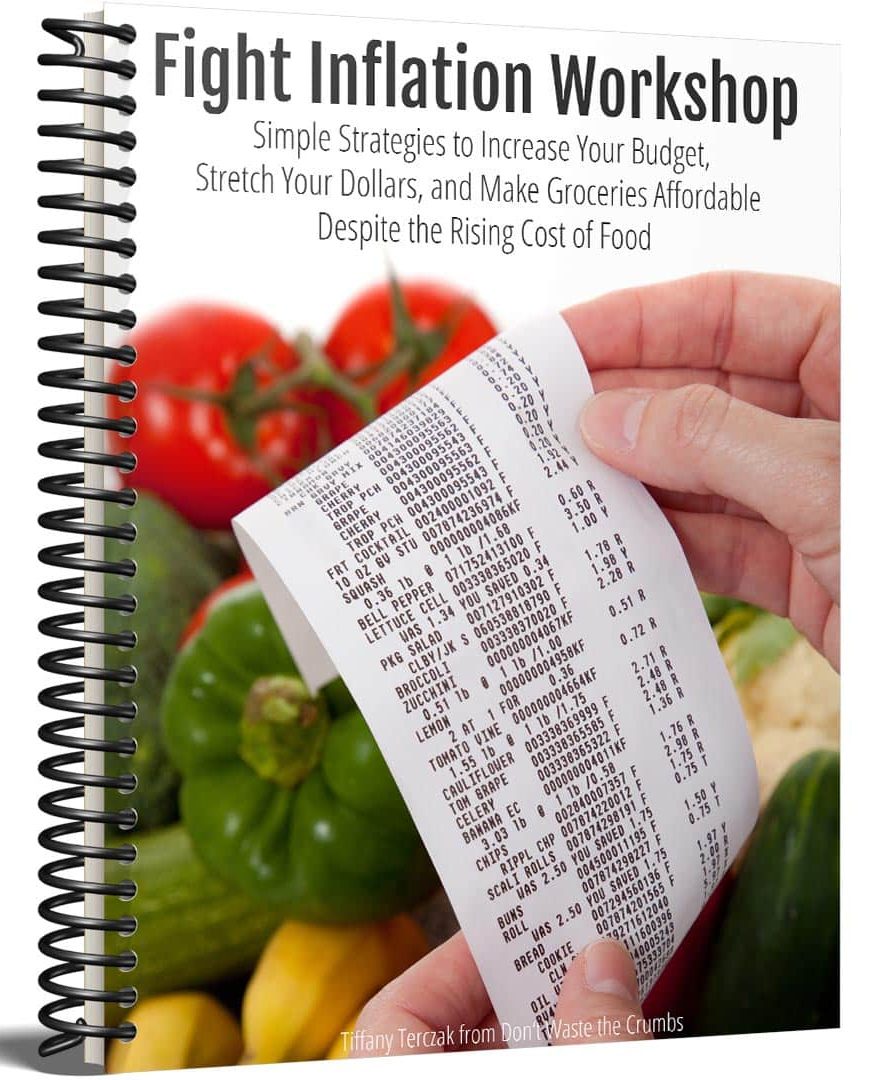
Fight Inflation Workshop!
Sign up for my FREE Fight Inflation Workshop and learn simple strategies to save money, even with rising food costs!Homemade Laundry Detergent (for sensitive skin): DIY
Mix up a batch of this homemade laundry detergent with just a few simple, frugal ingredients to keep your clothes clean and bright. Using goat milk soap makes this the perfect homemade laundry detergent for sensitive skin, and you get to choose the scent by mixing in your favorite essential oils.
- Prep Time: 5 minutes
- Cook Time: 0 minutes
- Total Time: 5 minutes
- Yield: 40 Tbs 1x
- Category: DIY Household
- Method: No Cook
Ingredients
- 1 bar goat milk soap (I recommend Bend Soap Company), shredded for 1 cup of soap shreds
- ½ cup baking soda
- ½ cup borax
- ½ cup super washing soda
- 20 drops of essential oils (optional, but recommended if you like your clothes to have a certain scent other than clean)
Instructions
1. Using a grater, grate your goat milk soap until you have 1 cup of soap shreds. To save time, grate the entire bar and store excess shreds in a container with a lid.
2. In a container with a lid, combine all ingredients. Seal well and shake vigorously until all the ingredients are well combined. Be careful when opening the container as small dust-like particles of the ingredients will become airborne.
Notes
- Safety Precaution: Although safe for external use, Borax should not be inhaled. Therefore it is best to use either a mask or some sort of protective barrier over your mouth and nose when handling it and opening the container for the first time.
- Also, as a precaution, use protective gloves if you have cuts or open wounds on your hands.
- Use one tablespoon for light loads, and two tablespoons for heavy loads. This recipe makes enough for 40 tablespoons, which lasts my family approximately one month.
- For essential oils, my favorite company is Plant Therapy. You can find their shop here.

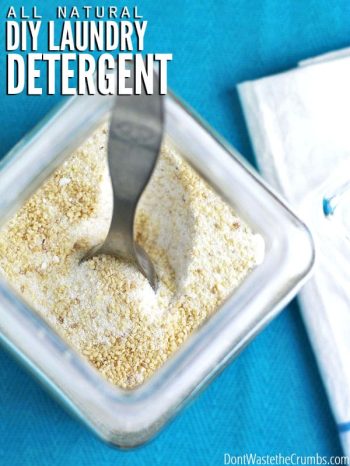
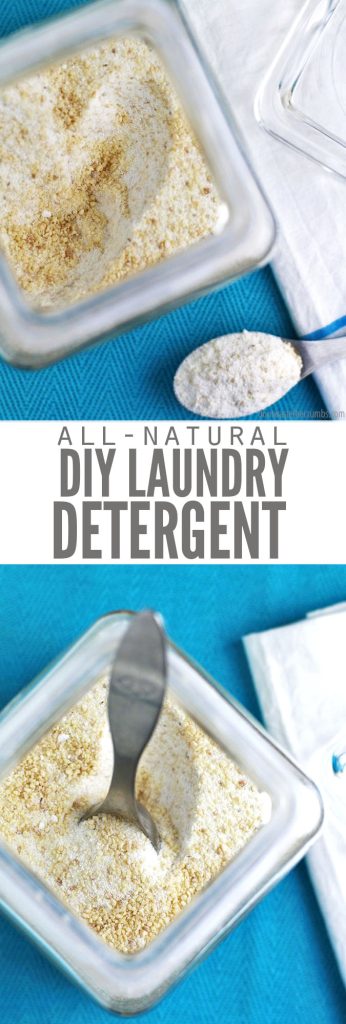
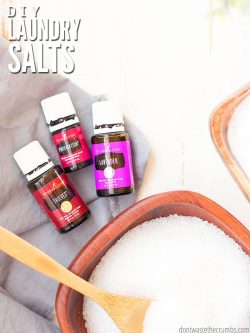
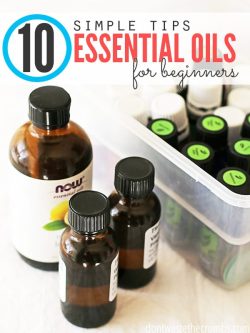
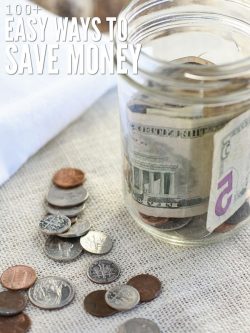
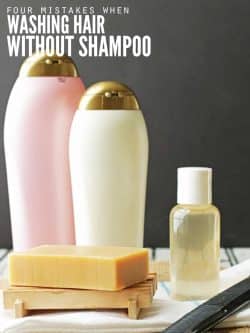

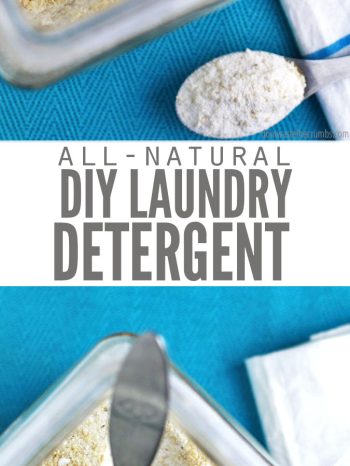
Are there any other soaps that you can use other than goat milk soap? I’m lactose intolerant and also vegan, so I’d rather not use that particular kind of soap. I would greatly appreciate any recommendations. Thank you!
I dot NOT recommend this for HE washers as it will leave a nasty, funky film inside your machine that will continue to slough off every wash & leave nasty bits of filth on your clothes. No more homemade laundry soap for me :(.
Are you still making this? I am trying to find one to switch to. I make our own but as you said those stains are just sorta creepin up and it’s what I wear to work.
So I gave this a shot, no essential oils as I just wanted to keep this as simple as possible. I had a surgery a year ago that required a lot of antibiotics which caused a yeast infection. The medication prescribed from the yeast infection caused an adverse reaction and even after I got off all the meds I was still in a lot of pain and discomfort. So I switched to brands like All or laundry detergent for babies, I used a bidet and/or very thin toilet paper (less chemicals). But I was still having issues.
I decided to make your laundry detergent and for the first time in a long time I feel significantly better within just a few days of using the detergent. This has been such a blessing and a relief. So thankful that you posted this! The instructions were easy, although the cost for the soap is way way off so I’ll have to buy in bulk to equal the cost of my last detergent, however, I didn’t make this for cost savings, I chose to make this for health reasons. So I don’t mind if it’s a little more expensive than what I used to buy.
Thanks again!
Did you know none of the links for info on purchasing EO’s through you are working?
I didn’t until just a moment ago – but they’re fixed now!!
Hello! I have been reading you DIY blogs for making your own laundry soap. I’m wondering if there is a way to make a liquid laundry soap? Sorry, I didn’t read the comments if the answer is in there.
There is Andrea, but it requires a completely different set of materials. I haven’t found a solid liquid detergent that I love just yet either.
Yea for goat milk soap!!!! I have been making my own for 4 yeas. After it is soap, I add the super fats of cocoa. shea, mango butters, coconut oil, EVOO, Greek yogurt, oatmeal IN ADDITION to the goat milk which is also added at the end. The lye touches any of these. I use other oils . My skin ls like a baby’s. Great for gifts.
For laundry, I ,make a 100% coconut oil soap. It has excellent cleaning properties. You can use much less of this since it is very concentrated
.
I now make it liquid – since it starts liquid, it never separates.
OK, I guess this is an ad for making your own soap. so much fun!
Hi Rita,
Can you send your recipes for the goat milk soap and coconut milk soap? I am very interested in making my own.
thanks!
Hi,
I am glad you are interested in making soap. I find it rewarding. I am not artsy/crafty like so many ladies.
Can’t even tie a pretty bow!
I started with hot process, and now use the fluid hot process (for bars).
These 2 methods are both for bar soap and use KOH (potassium hydroxide) lye.
With this method you can make the soap (after gel stage) and then add all the other stuff such as the goat milk, Greek yogurt, oatmeal, and of course the superfas.
I like www.soapalc.com to figure lye, water, oils amounts. Currently they only do single lye, but will soon be out with dual lye(for liquid soap).
I do a print out for EACH batch and keep in a binder. I also keep the receipt for all supplies.
I have a spreadsheet for supplies(cost,amount=price per ounce) which is linked to the one for each batch. That way, you know how much per ounce it costs to make.
I measure everything on a digital scale.
The internet is prolific with videos and info. Face Book has a hot process and a liquid process groups. I recommend joining as they have much info and you can ask questions.
One thing to remember is to use a croc size that the oils+lye & water will cover your stick blender.
Be VERY careful not to tilt the blender. Don’t want it to splatter on you (ouch) or painted cabinets. It will strip the paint down to the wood.
I started out watching Kinmerly McNutt Videos. She has many recipes. Her basic recipe is 8 oz coconut oil, 13 oz lard, 13 oz soybean oil. Using some castor oil, helps make more lather, olive more conditioning. The combinations are endless. Each oil has it’s own special properties. Since I have spent my 4 years coming up the “the one” I like the best, I do not share it. SoapCalc has a quality section which matches your qualities to a range. In the Notes & additives section, I copy/paste my own notes pre saved in Word. Be sure to keep account of how much fragrance and how it turned out. All for future reference. I like Natures Garden. Their Fragrance oils are strong. Many companies sell oils and other supplies. I buy the coconut oil by the gallon from Amazon – $20. Also cook with it. Lard and soybean oil in the grocery store. Need both hard and soft oils. Lard is a staple in south TX. For superfatting, I use Organic oils.
For my goat milk soaps, I figure 1% superfat in a lye calculator (soap calc), then AFTER the cook, super fat it to 10% with oils and butters. Kim McNutt has a video on how to superfat.
Tina Moenck has videos on youtube also.
Many start with cold process, which I started with in the 70’s. I used my aunt’s recipe from her antique shop. Either all lard or all bacon grease. Both great laundry soaps. Now a coffee can is no longer a pound. Cold process is very easy. Mix it all together, pour into the mold, and wait for it to cure. Pretty sure all the commercial ones are like this. Being a perfectionist, I don’t want the lye to touch my expensive oils and butters nor the goat milk. The sugar in the milk sort of burns or reacts with the lye & turns it a bit dark. Titanium Dioxide will bring it back to white. Adding the milk at the end of the cook keeps it white, and preserves the qualities in the goat milk. You never know how the goat milk was treated. Raw organic goat milk is not available to me. I use the powder & mix it with a little water to make a slurry to add at the end. You will know when the soap is “done”. It will lather & pass the zap test ( a little on the tongue will taste like soap). It should be rather fluid ( at least 140 degrees) to mold.
If you want to make a great just laundry bar, use 100% coconut oil. Not good for skin though.
You can grate it just like Fels-Naptha as in many recipes. I always had a problem with it separating so this year started learning to make liquid soap. It uses a different type of lye(NaOH)
It is cooked to a hard paste, then diluted (dissolved). IT will be thin as water, I use a little Xanthan gum to thicken a bit. Have made several batches of laundry soap, and also the thick shower gel one (recipe on the FB group notes). Made approx 3/4 gallon for about $6 – all natural.
I watched videos for 3 months & read and researched before making my first batch.
I don’t normally use colors or do those fancy swirls. Just natural great soap.
It is a journey. I have also make Liz Ardly’s apple cider vinegar shampoo bar. Yep, ACV instead of water. Must use a vinegar after rinse also. Commercial products coat the hair shaft with who knows what! Ever read the ingredients of Dove “Beauty Bar”? Definitely nothing “natural” about that.
How many loads does this make?
I haven’t counted Rebecca, since you can use 1-2 Tbsp per load. This lasts my family 4-6 weeks though.
I used to make my own laundry detergent until my son told me that Borax is very bad for the environment.
He used to live in Sundre, Alberta, a very small town, and they stopped selling it there.
Is there something else that could be used instead?
Are you still using this soap? I’m new here and can’t wait to make some of your recipes
I certainly am Heather! Going on 2 1/2 years now. 🙂
I’m having some difficulty with this detergent dissolving in my front loading machine. Sometimes a “cake” of detergent is left after the cycle is over. Thoughts?
I’m hoping someone else can chime in Rochelle, because I haven’t had any issues with my front loader. 🙁
Thanks for responding! I made more today and used the food processor this time. Hoping the small soap pieces will help. I’ll let you know! I love your site, thank you for all you share!
We don’t know if it’s completely honest to omit lye from the ingredients list. Here is what it says on Bend Soap’s website: “Fresh Goat’s Milk, Saponified Coconut, Olive, and Palm Oils, Essential Oils (Clove, Cinnamon, Orange, Lemon, Eucalyptus, and Rosemary). That’s it!”
Some people are commenting on their website how happy they are that there is no lye in their soap. This is what we read and also assumed that somehow there was no lye in it.
We checked other goat milk soaps on Amazon and one of them states: the ingredients are: Olive oil, coconut oil, sustainable organic palm oil, raw goat milk, sodium hydroxide (lye), vitamin E, organic oatmeal, and raw honey.
Thanks Tiffany for contacting them.
Anna – You’re welcome for the information, but I’m going to have to interject here and state that if you believe Bend Soap should change their labeling, please discuss this directly with them. I fully support Bend Soap Company, their mission and their products, but this is not an open forum to discuss preferences on labeling. Thanks for understanding!
Saponification happens when lye and water are added to oils. It is a chemical process involving heat. After it is done, it is neither, lye, water, nor oils. It is soap. So saponified (oil list) means those oils were mixed with the lye & water and went through the process and were turned into soap. Notice that “body wash” does not say soap because it probably isn’t. It has a long list if ingredients that only a chemist can pronounce. There is a lot of information on the net explaining the difference between soaps and other cleaning products including laundry and personal. Dawn dish washing liquid never claims to be soap. Sodium lauryl sulfate (SLS) creates bubbles/lather. Check your shampoo & other labels. Hope this bit trivia helps.
Hi I JUST now checking this website not sure if I’ll get am answer but I would like to try this for my son and husband who suffer from eczema. What kind of goat soap do I but I was checking Amazon and a 4 pack $1.10/ounce is $19.84. Is this a good deal? BUT my main question is what scent did you get? As I see they gave different ones as well as unscented.
Gladis – I use soap from Bend Soap Company: https://dontwastethecrumbs.com/go/bendsoap. You can use any scent, but if their skin is very sensitive, I’d go with unscented.
Thank you for your response. Do you have a diy for lip balm/moisturizer?
Yes! Here: https://dontwastethecrumbs.com/2014/12/homemade-lip-scrub-and-peppermint-lip-balm/ and there’s good info on buying options here: https://dontwastethecrumbs.com/2016/09/heal-chapped-lips-naturally/
Bend Soap claims there is no lye or glycerin in their soap, but after googling we found out that soap cannot be made with just oils, goat milk and essential oils. Anybody has a different experience?
Hi Anna – I’ll contact Bend Soap directly and share their answer here. 🙂
Hi Anna – can you tell me where it states that Bend Soap doesn’t use lye? Here is their answer: “We absolutely use lye… The lye is chemically changed in the saponification process. The final bar soap does not have lye in it.”
It’s a simple answer, but let me know if you need more information. 🙂
Hi!
Is this soap safe for HE machines?
Hi, I am thinking of making this soap this weekend! Can I use any goats milk soap? Or does it have to be a kind specifically for laundry? Also, does this detergent fade clothes faster than usual?
Hi Amy – yes, you can use any soap really. I like Bend Soap Company b/c it’s gentle on our sensitive skin. As for fading, nope! We haven’t experienced any fading issues.
Hi,
My concern about this soap recipe is Borax….It is not a healthy even though itr is a natural component. Borax is used to kill coach roaches when they eat it.Can something else be used instead?
I am also concerned about the Borax, because I have read (on other DIY laundry detergent recipes) that some people have a slight reaction to it. Others noted a reaction to the washing soda, so they cut it and substituted baking soda for part of the washing soda.
Since I have been using my homemade laundry detergent (with borax, washing soda and goats milk soap), I have had noticeably dryer skin, but I have not been able to determine if the detergent is the cause.
If you find an alternative to Borax or more information about it, please let me know!
Hi, I was curious about the soap (been wanting to try it for a while now 😉 ) you list the cost above as $1.20. Is this for the regular size bar? The website now lists it as $4.95 which makes the cost considerably higher. Thank you!
Hi Sheri! That’s the cost of the portion of the bar I shredded – so it takes roughly 1/3 of a bar to make this batch of laundry soap. Right now Bend Soap Company is having a sale on their bulk soap. They make soap in really big logs, then cut it into the bar-sizes. The “bulk scrap soap” are the non-uniform pieces from the end of the big log. Exact same soap, just not the “perfect” size – but it’s perfect for frugal folks and shredding into soap. 🙂 Take advantage while you can b/c they ALWAYS sell out fast!
Do you know if it still works well without washing soda? Because I have a terrible allergy from it.
You can Soji, but washing soda is a laundry booster and a concentrated form of baking soda. I would suggest adding a different type of booster to compensate.
Hi! Do I necessarily need to add the Borax and the super washing soda? I’m currently living in Finland and stuff here is either really hard to find (mostly since it’s all written in Finnish and Swedish and some workers at the shop won’t help or just don’t speak English) or it is too expensive.
Also, once I make this, can I use it for handwashing? I am not yet sure if I can use it in the washing machine at home.
Thanks in advance for this great ideas!! 🙂
Hi Alejandra! Yes, you need both for cleaning purposes. And I wouldn’t recommend for hand washing. 🙂 If you need a simple soap for hands, try this one: https://dontwastethecrumbs.com/2015/11/diy-homemade-hand-soap/!
What does the baking soda do? It’s the first time we see it used in a recipe for lau dry detergent. Thanks.
Baking soda helps to soften the water, allowing the soap to do its job better. 🙂
Hi, Tiffany,
Are you still using this recipe on your clothes? I made my own detergent for years (with Ivory, Fels Naptha, washing soda, and Borax, so very similar), and while I liked it at first, over time it seemed to work less well. I started having problems with white grainy residue on my clothes like the above commenter, and my clothes just always seemed dingy, even right out of the wash.
You’re not supposed to use homemade detergents on cloth diapers, so I gave up on homemade and went back to a natural commercial brand. But I’m down to one in diapers and wondering about making my own again…it’s certainly cheaper! So I was wondering if you had an update, a year + later. 🙂
Yes! I still am Katie! I’ve been experimenting with various amounts, and trying a liquid detergent too, but I just made another big batch of this last week to get me through the next several months!
Do you still find that this recipe works well, or have you found something better in your experimentation with different amounts? I dabbled in homemade detergents, but it seemed like no matter how much EO I put in with the was, our clothes just smelled like… heat I guess. You know the smell when someone has been out in the heat and then comes back inside and sits next to you? lol They didn’t smell nice. I tried adding EOs to dryer balls as well with no luck whatsoever, and ended up going back to commercial detergent and dryer sheets! I tried making homemade dryer sheets with t-shirt squares soaked in vinegar with EO and that DID NOT work either. Still using my dryer balls though also. I just NEED HELP with my laundry! haha
Hi Heather! I’m still using this recipe and it’s still working, although the water in GA is different in CA and I’m not sure if the detergent is working AS well as it was. Smell wise, it’s fine. But I need to experiment more after we move (again!) with other ingredients to see if this can be improved for all water types. Your real struggle though is with the scent? What if you turned the heat down on the dryer and did the EO’s with dryer balls in a greater quantity?
The only way I’ve ever had scent success with homemade laundry options is to fully dry the clothes with the dryer balls, take the balls out and apply EOs, put them back in with the dry clothes, and run a short low (or no) heat cycle.
Well that’s the thing! I use the low heat setting on all my clothes, so I’m just stumped! I did omy use like 5 drops on the dryer balls, but then even that is a lot to use for every load. Don’t want to waste my good oils! Maybe I’ll give this a shot and see how it does. I did just make up a batch of the bleach and included the citric acid since I happened to have some on hand, but it didn’t seem to do much for my whites 🙁 🙁
Strange… I’ll keep thinking Heather and let you know if I come up with anything, but unfortunately I’m kinda stumped at the moment. Hopefully another reader can chime in here!